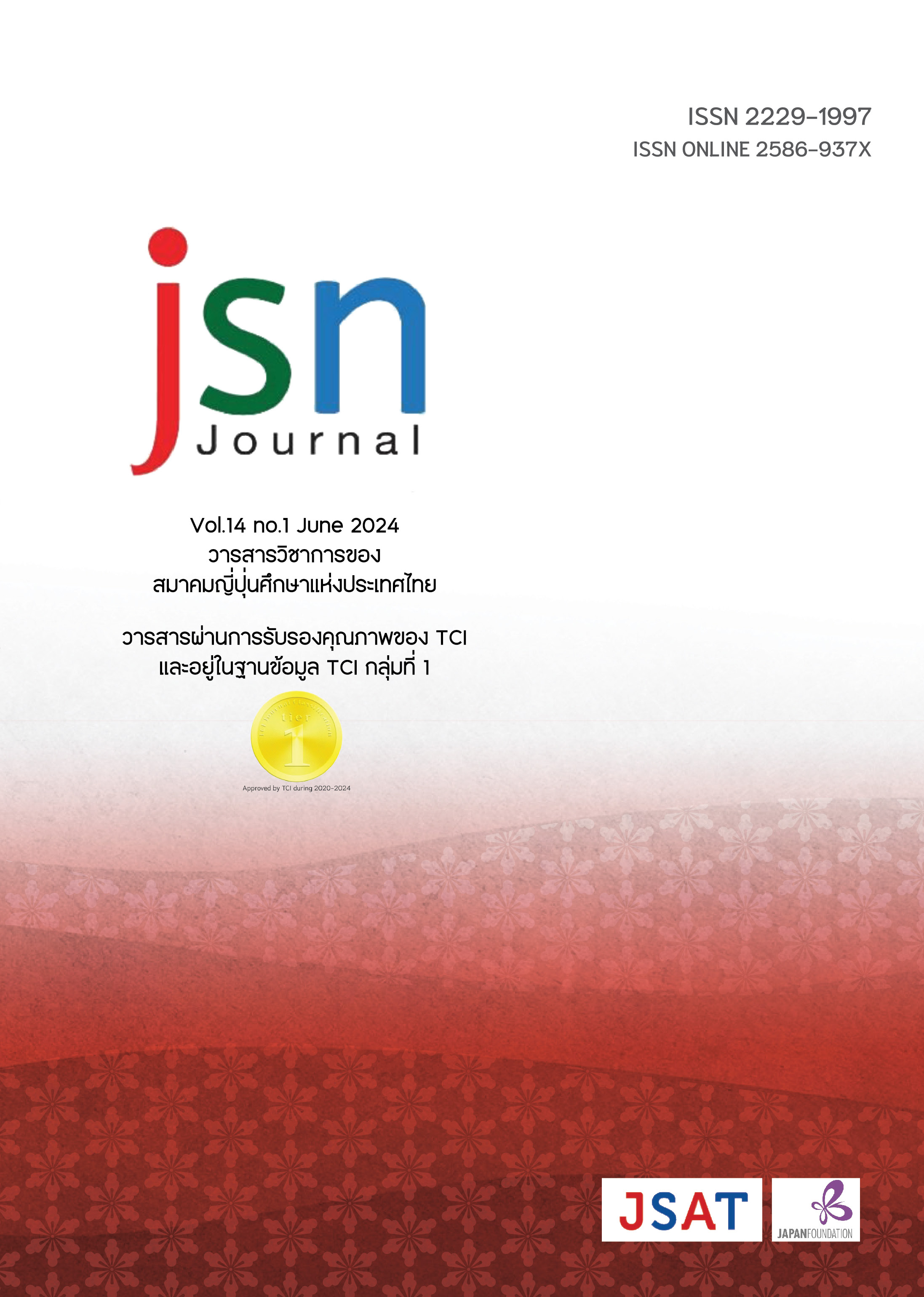The Role Language of Boku-shoujo and Orekko-type Characters in Japanese Animation
Main Article Content
Abstract
This study examines the role language of two types of female characters, namely “Boku-shoujo” and “Orekko,” in Japanese animations by analyzing the use of the Japanese masculine first person pronoun (“Boku” and “Ore”) and gender-specific sentence endings. Data were collected from six Japanese animations and analyzed in order to identify how the Japanese masculine first-person pronoun, and gender-specific sentence endings were used as role language. The results showed that eight characters in the Boku-shoujo type used the pronoun “Boku,” and seven characters in the Orekko used “Ore” without changing in any situation. All of the Orekko-type characters also used masculine sentence endings more often than the Boku-shoujo did. Despite the predominantly feminine appearances of the characters, there is no evident distinction between the Boku-shoujo and Orekko types. However, Orekko-type characters are typically assigned roles related to combat and exhibit more masculinity in their language compared to Boku-shoujo-type characters. Consequently, based on the findings of this research, it can be concluded that the language used by female characters is specifically tailored to indicate the diverse roles of these characters in the story. Female characters with combat roles and a more assertive demeanor employ the masculine pronoun "Ore" and exhibit more masculine sentence endings. In contrast, Boku-shoujo-type characters demonstrate masculinity when performing combat-related roles while still maintaining a cute, feminine quality.
Article Details

This work is licensed under a Creative Commons Attribution-NonCommercial-NoDerivatives 4.0 International License.
ข้อความและข้อคิดเห็นต่างๆ ในบทความเป็นของผู้เขียนบทความนั้นๆ ไม่ใช่ความเห็นของกองบรรณาธิการหรือของวารสาร jsn Journal
References
กนกวรรณ เลาหบูรณะกิจ คะตะกิริ (บรรณาธิการ), บุษบา บรรจงมณี, พัชราพร แก้วกฤษฎางค์, สุณีย์รัตน์ เนียรเจริญสุข, สมเกียรติ เชวงกิจวณิช. (2558). ศาสตร์ภาษาญี่ปุ่นที่ควรรู้. กรุงเทพมหานคร: สำนักพิมพ์แห่งจุฬาลงกรณ์มหาวิทยาลัย.
พัชราพร แก้วกฤษฎางค์. (2566). ภาษาญี่ปุ่นเชิงสังคมและวัฒนธรรม. กรุงเทพฯ: สำนักพิมพ์มหาวิทยาลัยธรรมศาสตร์.
ร้อยแก้ว สิริอาชา. (2564). แนวคิดเรื่องภาษาบทบาท (ยะขุวะริโกะ) และความเป็นไปได้ในการศึกษาในภาษาไทย. รายงานสืบเนื่องจากการประชุมวิชาการระดับชาติหัวข้อ "ภาษาและวัฒนธรรมไทยในวิถีโลกใหม่" Vol.1 No. Proceeding Report, pp.103-122. http://www.hurujournal.ru.ac.th/journals/30_1656648361.pdf
遠藤織枝 (2002).「男性のことばの文末」『男性のことば・職場編』現代日本語研究会編.
小川早百合 (2004).「話し言葉の男女差 : 定義・意識・実際」『日本語ジェンダー学会』4, 26-39.
尾崎喜光 (2004).「日本語の男女差の現状と評価意識」『日本語学』23(7), 48-55.
黒須理紗子 (2003).「女ことば・男ことばの研究 : 差異と変遷」『日本文學』104, 187-203.
金水敏 (2011).「役割語と日本語教育」『日本語教育』150, 34-41.
金水敏 (2014).『〈役割語〉小辞典』東京:研究者.
金水敏 (2023).『ヴァーチャル日本語 役割語の謎』東京:岩波書店.
国語学会編 (1980).『国語学大辞典』東京:東京堂出版.
佐竹久仁子 (2003). 「テレビアニメの流布する「女ことば/男ことば」規範」『ことば:研究誌』24, 43-59.
富樫純一・浅野総一郎 (2012).「自称詞「ぼく」と女性キャラクター ―いわゆる「ボクっ娘」の役割語的分析―」. 第123回関東日本語談話会. http://www.ic.daito.ac.jp/~jtogashi/articles/togashi_asano2012.pdf
戸田利彦 (2004).「外来語に関する基礎的研究(XIII)—“若気”にかかわる外来系「な」形容詞の意味用論」『比治山大学現代文学部紀要』11, 23-32.
西田隆政 (2012).「「ボク少女」の言語表現 ―常用性のある「属性表現」と役割語との接点―」『甲南女子大学研究紀要』48, 13-22.
西澤萌希 (2021).「《ボク》キャラと《オレ》キャラの接点 : ことばとキャラクタの結びつきに注目 して」『名古屋大学人文学フォーラム』4, 185-200.
松村明編 (2008).『スーパー大辞林3.0』東京:三省堂.
安田芳子・小川早百合・品川なぎさ (1999).「現代日本語における男女差の現れと日本語教育-意識・実態調査-」『 小出記念日本語教育研究会論文集』7, 73-90.
山中靖子 (2008).「現代日本語の性差に関する研究―文末表現を中心に―」『東京女子大学言語文化研究』17, 87-100.
「オレっ娘」『ニコニコ大百科』https://dic.nicovideo.jp/t/a/オレっ娘?from=a_%20autolink_558387 (สืบค้นวันที่ 30 มิถุนายน 2566)
「ボク少女」『フリー百科事典 ウィキペディア日本語版』https://ja.wikipedia.org/wiki/ボク少女 (สืบค้นวันที่ 30 มิถุนายน 2566)
「ボク少女」『ニコニコ大百科』https://dic.nicovideo.jp/t/a/ボクっ娘?%20from=search_a (สืบค้นวันที่ 30 มิถุนายน 2566)
「ボーイッシュ」『ニコニコ大百科』https://dic.nicovideo.jp/t/a/ボーイッシュ?from=search_a (สืบค้นวันที่ 30 มิถุนายน 2566)


